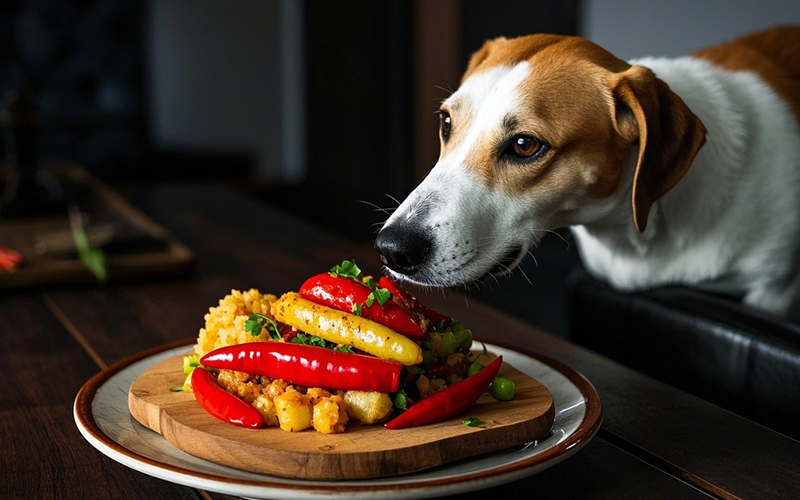Can Dogs Eat Spicy Food? The Dangers of Feeding Spicy Food to Your Dog
- 24 Mar 2025 14:19
Spicy food may be a favorite for many humans, but when it comes to your dog, spicy food is a big no-no. Dogs’ digestive systems are not equipped to handle the intense heat and spices found in certain foods, and feeding them spicy food can lead to a variety of unpleasant and dangerous side effects. Let’s take a closer look at why spicy food should be avoided and what to do if your dog accidentally eats something spicy. 🚫🌶️

Why Spicy Food Is Bad for Dogs
1. Upset Stomach and Digestive Issues
Dogs have much more sensitive stomachs than humans, and spicy food can easily cause digestive problems. Ingredients like chili peppers, cayenne pepper, and hot spices can irritate your dog’s stomach lining, leading to symptoms like vomiting, diarrhea, and gas. Over time, eating spicy food can result in more severe issues like gastritis (inflammation of the stomach) or ulcers. 🤢
2. Risk of Poisoning
Many spicy foods contain chili peppers or hot sauces, which are not only uncomfortable for dogs but can also be toxic. Certain compounds in chili peppers, particularly capsaicin, can cause a range of toxic symptoms in dogs. Capsaicin is what gives peppers their heat, and while it’s not usually deadly, it can still cause serious discomfort and distress. Symptoms of capsaicin toxicity include drooling, excessive panting, and irritability. 💥
3. Mouth and Throat Irritation
Dogs may also experience burning sensations in their mouths and throats after eating spicy food. Since they can’t understand what’s happening, they might drool excessively, paw at their face, or even refuse to eat or drink due to the pain and irritation. 😣
4. Risk of Long-Term Health Issues
Regular consumption of spicy foods can contribute to long-term gastrointestinal distress in dogs. The constant irritation to the stomach and intestines can lead to chronic issues like acid reflux or even pancreatitis, a painful condition where the pancreas becomes inflamed. Spicy foods can also exacerbate any preexisting sensitive stomach conditions your dog may have. 💔
What Happens If Your Dog Eats Spicy Food?
If your dog accidentally eats spicy food, it’s important to monitor them closely for any signs of distress. The symptoms of eating something spicy can vary depending on the amount consumed, but they might include:
Excessive drooling 💦
Vomiting or diarrhea 🤮
Excessive panting or drooling (due to mouth irritation) 🐾
Painful stomach or abdominal discomfort 🤕
Lack of appetite 🥲
If your dog shows any of these symptoms after eating spicy food, it’s a good idea to contact a pet health professional for advice. You can also use PettureX for 24-hour online consultations if you need immediate guidance. 📱
How to Help Your Dog After Eating Spicy Food
If your dog eats spicy food, here are some steps you can take to help them feel better:
1. Provide Fresh Water
Make sure your dog has access to fresh, clean water to help flush out any irritants from their system. Spicy food can make your dog feel thirsty, and drinking water can help soothe their throat and stomach. 💧
2. Avoid Further Irritation
If your dog is in pain or seems to have digestive issues, avoid feeding them anything else that could irritate their stomach, including rich or fatty foods. Stick to a bland diet for a day or two, such as boiled chicken and rice, to give their stomach time to recover. 🍗
3. Monitor for Symptoms
Keep an eye on your dog for the next 24 hours. If their symptoms persist, worsen, or if they show signs of distress, contact a pet health professional immediately.
4. Consult PettureX for Fast Help
If you’re unsure how severe the situation is or need advice, PettureX provides 24-hour online consultations to offer expert guidance and peace of mind. 📱
What to Do in Case of Toxicity
In the rare event that your dog consumes a large amount of spicy food or shows signs of severe toxicity (like difficulty breathing, seizures, or extreme lethargy), it’s crucial to take them to a veterinary clinic immediately. The veterinarian may need to treat them with medication or fluids to help flush out the toxins. 🚑
The Bottom Line: Can Dogs Eat Spicy Food?
No, dogs should never eat spicy food. Spicy foods can cause a range of uncomfortable and dangerous symptoms, from digestive issues to more severe toxicity. Even small amounts can irritate your dog’s stomach, cause pain, or lead to health complications.
To keep your dog safe, stick to dog-friendly treats and foods, and avoid sharing anything spicy or seasoned with hot ingredients. 🐾💚
For concerns or questions about your dog’s health, PettureX offers 24-hour online consultations and pet image recognition to provide fast, reliable help. 🌟
Keep your dog happy and healthy by offering safe, gentle treats that won’t cause them any harm!
Related

Crunchy Curiosity: Can Dogs Safely Snack on Pork Rinds? A Deep Dive
- 21 Apr 2025
Pomegranate Seeds and Pooches: A Deep Dive into Whether Dogs Can Safely Indulge
- 21 Apr 2025
Can Dogs Eat Peaches? Vet Explains Benefits, Cyanide Risks & Safe Serving
- 16 Apr 2025
Can Dogs Eat Mulberries? Vet Explains Safety, Benefits & Potential Risks
- 16 Apr 2025
Can Dogs Eat Mozzarella? Vet Explains the Cheesy Truth (Risks & Benefits)
- 16 Apr 2025
Can Dogs Eat Maple Syrup? The Sugary Truth & Why Vets Advise Against It
- 16 Apr 2025
Can Dogs Eat Mango Skin? Vet Explains Why It's a Risky Chew!
- 16 Apr 2025
Can Dogs Eat Mac n Cheese? Vet Explains Why This Comfort Food Is Unsafe!
- 16 Apr 2025
Can Dogs Eat Liver? Vet Guide to This Nutrient-Dense Organ Meat (Benefits & Risks!)
- 16 Apr 2025
Can Dogs Eat Licorice? The Sweet Danger & Glycyrrhizin Risk Explained by Vets
- 16 Apr 2025
